My Basement Leaks After it Rains: A Common Homeowner Complaint
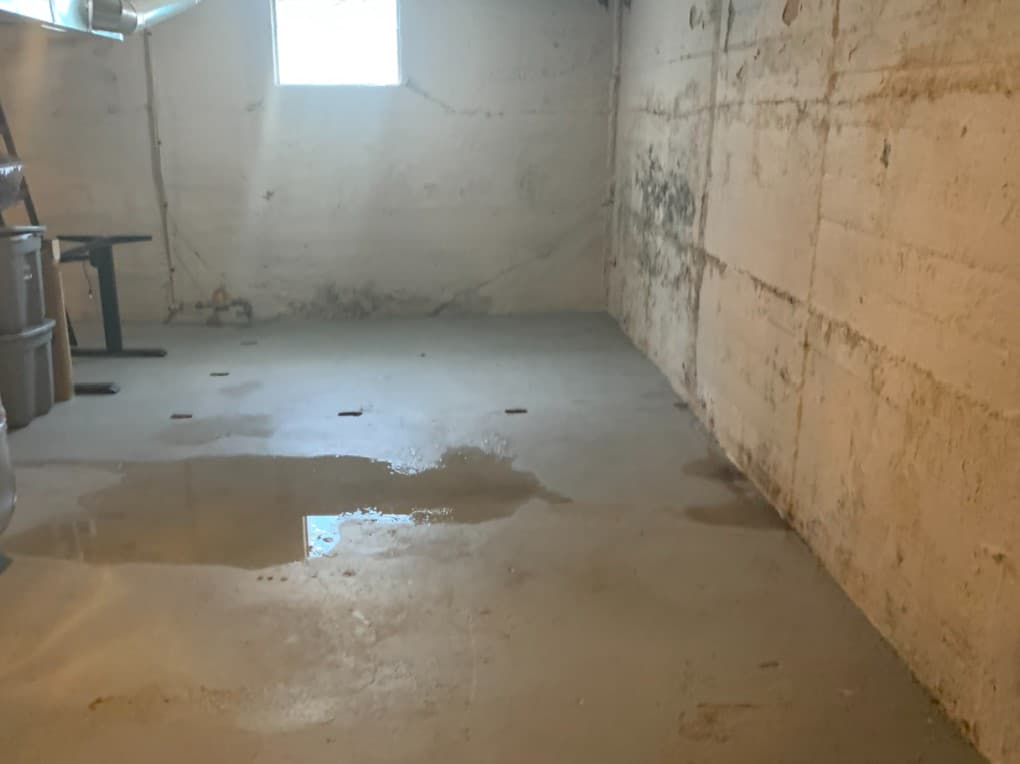
When you see rain in the forecast, does dread curl up in your stomach? Do you sigh to yourself, then rearrange your day’s plan to include mopping and cleaning your basement? If rainy days guarantee you’re going to have a flooded basement, it’s time for you to take action. Basements are not supposed to be wet, and you have better things to do with your time!
Acculevel has been repairing foundations and waterproofing homes since our start in 1996. We understand that a wet basement is frustrating for homeowners, but we also know that it’s an early warning sign of future foundation damage. Our goal is to help homeowners preserve and protect their homes; we focus on addressing both your immediate concerns and on how to prevent more severe problems from occurring in the future.
In this article, we’re going to cover three major topics: how you can reduce the water getting into your home, how to control the water that still comes in, and why accomplishing these tasks will protect the value and health of your home.
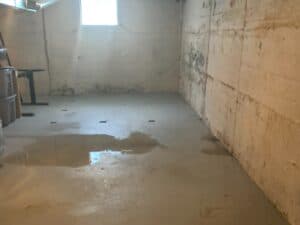
This photo was taken by an Acculevel project advisor during a free in-home assessment. Water is seeping into the basement through the cove joint (connecting point between wall and floor).
How Can I Prevent My Basement From Leaking?
We don’t want to deceive you; if water is truly determined to invade your home, it’s going to find a way to do so. However, there are steps you can take that will reduce the amount of water that seeps in.
How to Reduce the Water Getting into My Basement
- Begin by evaluating your house from the inside. Are there specific places that always seem to get wet? Are they damp right now? Check these spots first; are there any water sources that could be leaking? Examine possible culprits like pipe fittings, plumbing connections, or your appliances (clothes washer, water heater). If any of these are damp or showing signs of leakage, start with your local plumber or general contractor.
- Once you’ve addressed those potential threats, take your examination outside the house. You’ll need a ladder for this, so you can check your guttering for clogs or damage. This may seem trivial, but an overflowing gutter will dump water over the side. This means it will be landing right next to your foundation, so it will only have to travel a short distance into your home.
- Along with the guttering, check the downspouts. If they are clogged, they need to be repaired. If they are clear, but only go a short distance (under 10 feet) from the foundation? You should extend your downspouts; this linked article includes a tutorial if you’re the DIY type.
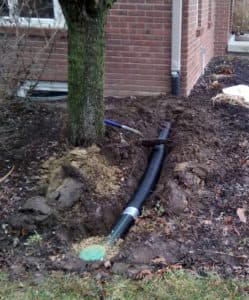
This photo was taken by an Acculevel team member, after installing a downspout extension for a homeowner.
Lastly, find a good vantage point somewhere around your property. You want it to have good sight lines to -and around- your home. This will allow you to visually evaluate the grading (landscape) of your property. The ground should gradually slope down and away from the house. This encourages any rainwater that lands by your home to roll “downhill.” Over time, this grading can become flattened, which is problematic because flat ground holds water and forms puddles. If they’re not draining away from your home, these puddles may then drain towards your home. This increases the chances of a wet basement. If you can see the grading is sub-par? Find and hire an experienced landscaping company to help.
How Can I Control the Water Getting into My Basement?
The best way to manage water intrusion varies, depending on how it’s getting through your basement walls or floor.
- Start by reviewing what you saw when you evaluated your basement from the inside. Did you find any cracks or gaps that were allowing water to seep in? Cracks should be repaired by a professional, preferably with an epoxy fill. Crack repairs are not a DIY- friendly project; filling a crack is nothing like re-caulking a bathtub.
- Does the water appear to be seeping in directly through the wall(s), or through the cove joint (where the wall and floor connect)? If so, your best option is to have water drainage installed.
- Another option to consider is basement encapsulation. If you are planning to finish your basement and convert it to living space, encapsulation will protect the insulation, drywall, carpet, and other finishing touches you’ll want to add.
- Also, if your foundation is built out of brick or stone, encapsulation is the smart way for you to waterproof your home. This is because these materials are more likely to allow water inside than concrete.
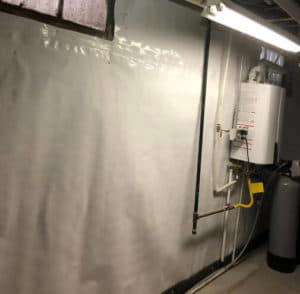
This photo was taken by an Acculevel team member, after encapsulating a homeowner’s brick basement.
Why is Water Management So Essential to Protecting My Home?
You have to manage water intrusion because it can be seriously damaging to your foundation, your air quality, and your health.
Hydrostatic Pressure Causes Foundation Damage
If there is a significant amount of water in the ground around your foundation, it’s capable of exerting hydrostatic pressure on the basement walls. This can lead to significant cracks or bowing in the walls.
Preventative maintenance like cleaning your gutters and extending downspouts can reduce the water next to your foundation and relieve some of that pressure. If your basement already has long horizontal cracks or zig-zag shaped cracks, you need this evaluated as soon as possible. These cracks are a clear indication that the wall is going to bow.
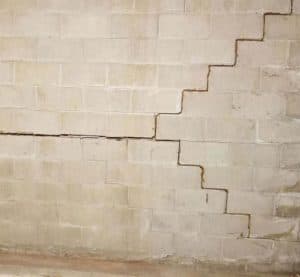
This photo was taken by an Acculevel project advisor during a free in-home assessment. These cracks are clear signs that hydrostatic pressure is forcing the wall to bow inward.
Humidity Causes Biological Growth
Any excess water inside your basement- even if it’s just damp air or moisture- can lead to mold, diseases, or other biological growth to form.
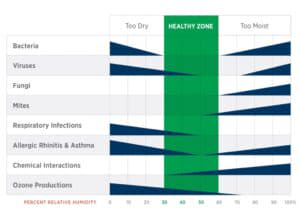
This chart is from a study published by the American Society of Heating, Refrigerating and Air-Conditioning Engineers (ASHRAE).
The chart above demonstrates what the ideal humidity level is for each of the major irritants, allergens, and diseases that thrive in a moist basement environment. A good quality dehumidifier can help you maintain a healthy humidity level in your home (50% is optimal).
Water Can Erode the Soil Under My Foundation
Water doesn’t have to enter your home to cause damage, either. If you routinely get a significant amount of rain in your basement every time it rains, you should also evaluate the main floor for signs of settling. The most common ones are cracks in the drywall, either in the ceiling or in the walls around door/window frames.
Settling is most often caused by water eroding the ground below the foundation. Water doesn’t smoothly erode across the entire foundation- it tends to “eat away” at one section or corner more than the others. This means one portion of the foundation is sinking (settling) to a lower depth than the rest of the home. This strains the foundation, creates cracks, damages door and window frames, warps staircases… settling can do major structural damage over time. You can learn more about settling and the best repair method – helical piers- in this article.
Acculevel Provides Additional Resources
If all of this information feels overwhelming or unmanageable, we have options for you!
- We have a detailed guide that will walk you through a DIY foundation inspection checklist. By following these steps, you can get a clearer understanding of what is happening around your home.
- Sign up for our Home Inspection Program (HIP). We will perform a thorough review of your home and potential issues, then explain the significance of our findings with you.
- Learn more about basement waterproofing with our comprehensive guide for homeowners. This is a resource we developed specifically to address all of the frequently asked questions we hear from customers about basement waterproofing methods, costs, and options.
Contact Acculevel for a Free In-home Assessment
If you are tired of having water in your basement, concerned about the health of your home, or worried about your foundation’s stability, call Acculevel! We are in the office Monday through Friday from 8 AM – 6 PM (EST), and our toll free number is 866-669-3349.
Prefer to communicate electronically? Fill out our online form and let us know you’d rather hear from us by text or email.
Not sure if you live within our service area? You can view our coverage map here; we serve all of Indiana and parts of the surrounding states.
If you don’t live in our service area, please still use the resources we’ve listed above. They are designed to help any homeowner with questions about basement waterproofing or foundation concerns, and can help you determine what type of contractor you will need. We also have a checklist of questions you should ask a company representative before deciding if they are the right fit for you and your home. We strongly recommend that you make certain any contractor you hire is properly insured and accredited by the Better Business Bureau.
